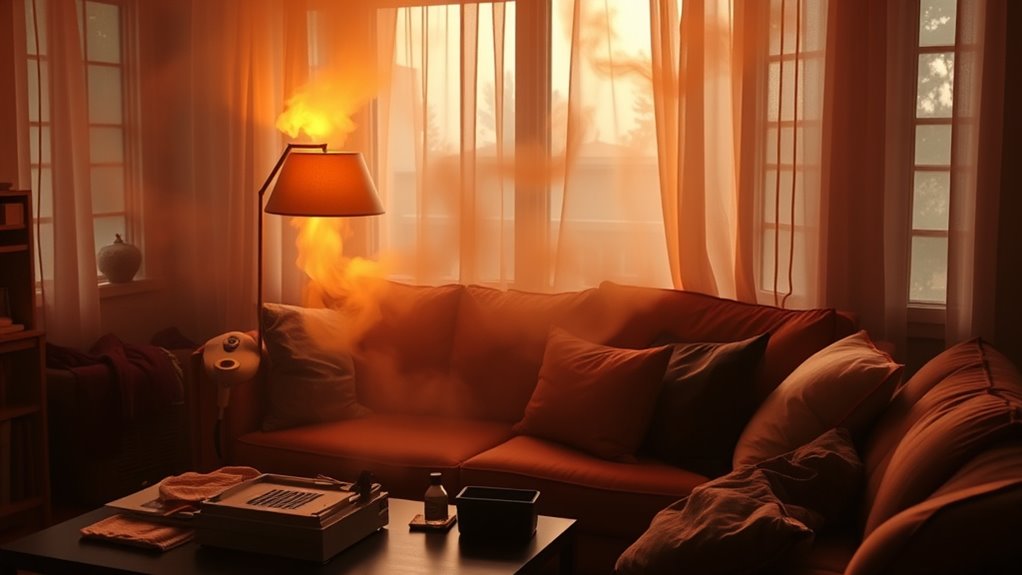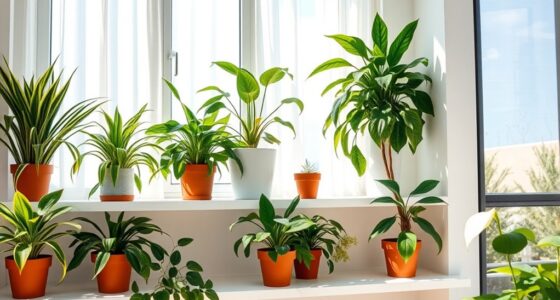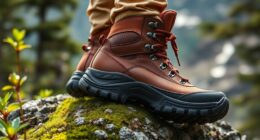To protect your lungs from wildfire smoke at home, stay indoors during smoky days and keep windows and doors sealed. Use air purifiers with HEPA filters and wear N95 masks if you need to go outside. Reduce activities that generate indoor pollutants and monitor air quality levels regularly. Creating a safe indoor environment is essential, and staying informed helps you act quickly. Keep exploring these tips to better safeguard your health during wildfire season.
Key Takeaways
- Use N95 masks and ensure a proper fit to filter out harmful wildfire smoke particles.
- Keep windows and doors closed, and run HEPA air purifiers to improve indoor air quality.
- Regularly monitor outdoor AQI and avoid outdoor activities during smoky conditions.
- Seal home leaks and vents to prevent outdoor smoke from entering indoor spaces.
- Limit outdoor exertion and schedule outdoor tasks during times of better air quality.
Understanding the Health Risks of Wildfire Smoke

Wildfire smoke poses serious health risks that can affect anyone, especially during active fire seasons. When you breathe in smoke, tiny particles called PM2.5 enter your lungs and bloodstream, causing irritation and inflammation. These particles can worsen asthma, bronchitis, and other respiratory conditions, making breathing difficult. Children, the elderly, and those with existing health issues are especially vulnerable. Short-term exposure can lead to coughing, sore throat, and chest discomfort, while prolonged exposure increases the risk of heart attacks and lung damage. Even healthy individuals may experience symptoms like headaches, fatigue, and dizziness. Recognizing these risks helps you take steps to protect your health, especially when wildfire smoke is thick and persistent in your area. Using home air purifiers with HEPA filters can significantly reduce indoor particle levels and improve air quality.
Creating a Safe Indoor Environment
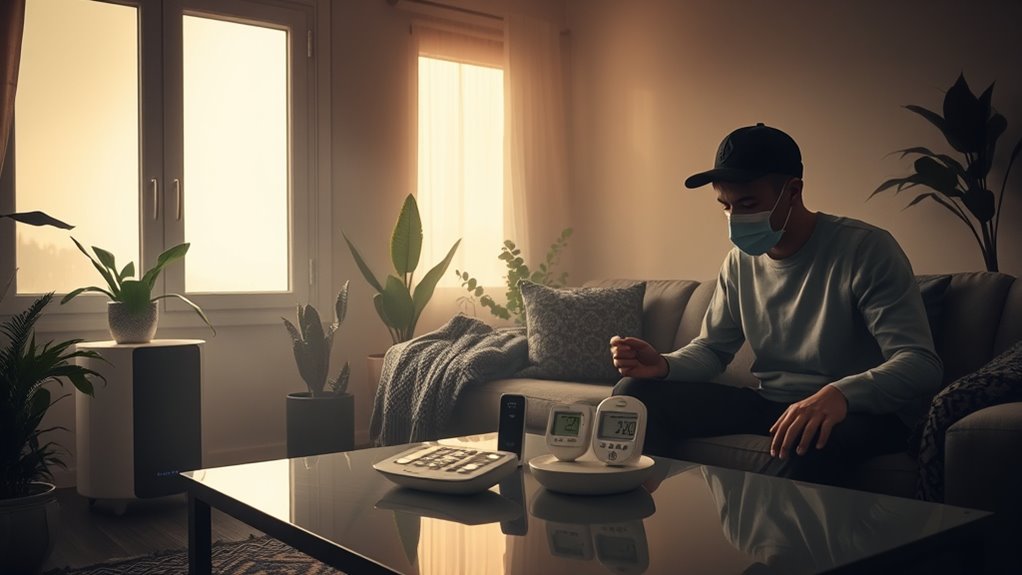
To reduce your exposure to harmful smoke indoors, it’s essential to create a safe environment by improving air quality. Start by keeping windows and doors closed to prevent outdoor smoke from entering. Use exhaust fans in your kitchen and bathroom to vent indoor pollutants outside. Avoid smoking or burning candles, as these add pollutants to the air. Limit activities that produce dust or fumes, like cleaning with harsh chemicals. Maintain good ventilation by circulating air with fans, but only when outdoor air is clean. Keep indoor spaces tidy to reduce dust buildup. Regularly inspect your home for leaks or gaps where smoke could seep in and seal them. Be aware of air quality levels to better understand when indoor air might be compromised. These steps help minimize indoor air pollution and protect your lungs during wildfire events.
Using Air Purifiers and Filters Effectively
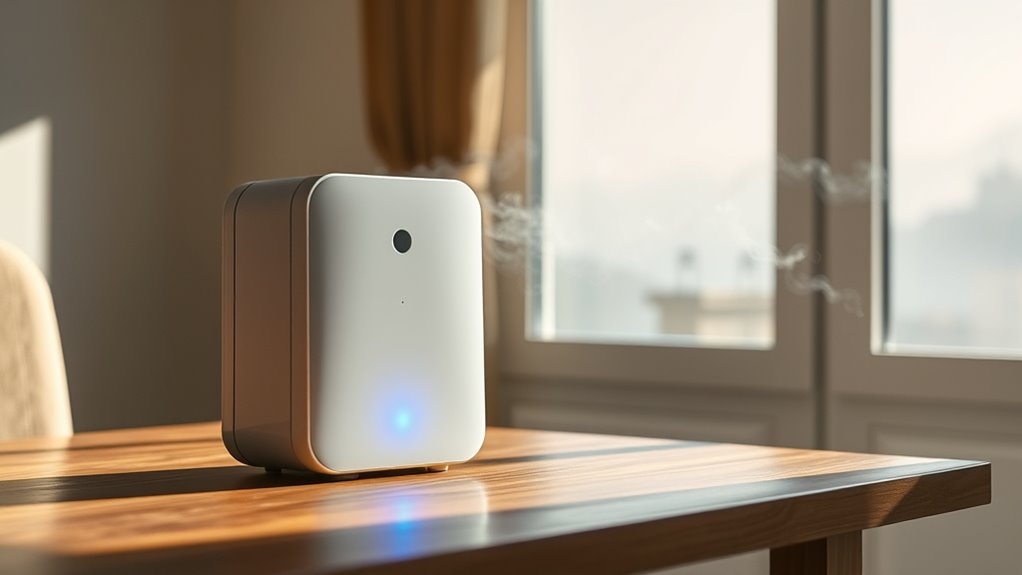
Using air purifiers and filters effectively can substantially improve indoor air quality during wildfire events. Choose a HEPA filter purifier, as it captures 99.97% of airborne particles, including smoke. Place the purifier in the main living area or where you spend most time, ensuring unobstructed airflow. Keep windows and doors closed to prevent smoke from entering, and run the purifier continuously for maximum results. Regularly replace or clean filters according to manufacturer instructions to maintain efficiency. Adjust the purifier’s settings based on air quality levels; higher fan speeds can help clear smoke faster. Incorporating auto functionality and smart technology can help optimize performance and monitor indoor air quality remotely. Combining this with good ventilation practices enhances the purifier’s effectiveness, creating a safer, healthier indoor environment during wildfire smoke episodes.
Sealing Your Home to Prevent Smoke Intrusion
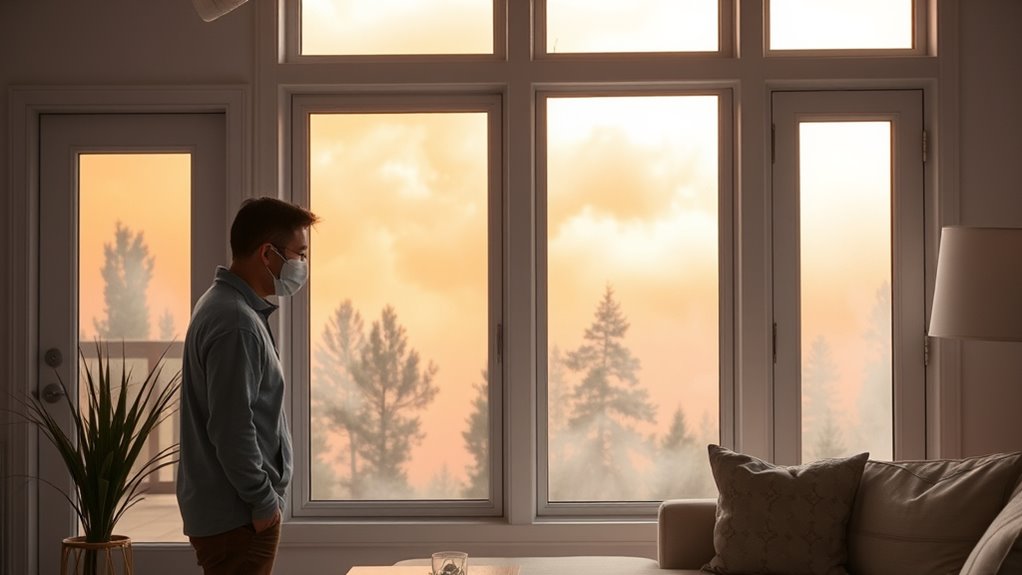
To keep smoke out, you should seal gaps and cracks around doors, windows, and vents. This simple step prevents outdoor smoke from sneaking inside and reduces indoor pollution. Combining sealing with air purifiers gives your home an extra layer of protection. Using eye patches can also help reduce irritation caused by indoor pollutants.
Seal Gaps and Cracks
Sealing gaps and cracks around your home is one of the most effective ways to prevent wildfire smoke from sneaking inside. Start by inspecting your windows, doors, and foundation for small openings. Use weatherstripping or caulk to seal gaps around window frames and doorjambs. Check for cracks in the walls, floors, and ceiling, and fill them with appropriate sealants. Don’t forget to inspect vents, utility openings, and electrical outlets—cover or seal these areas securely. Focus on areas where outside air can easily flow in, as these are prime pathways for smoke. Proper sealing stops smoky air from infiltrating your living space, helping you breathe easier and keep indoor air cleaner during wildfire events. Regular maintenance ensures your home stays sealed when you need it most. Incorporating air quality considerations into your sealing strategy can further improve indoor air safety during smoky conditions.
Use Air Purifiers
Even after sealing gaps and cracks, wildfire smoke can still enter your home through ventilation systems and tiny openings. Using air purifiers with HEPA filters is an effective way to reduce indoor smoke particles. Place purifiers in rooms where you spend the most time, such as bedrooms and living areas. Make sure your purifier is appropriately sized for the space, and run it continuously during smoky conditions. Keep doors and windows closed to prevent more smoke from getting in. Regularly change or clean the filters to maintain their effectiveness. Air purifiers won’t eliminate all indoor pollutants but can markedly improve air quality and protect your lungs during wildfire events. Combining this with sealing gaps offers a stronger defense against harmful smoke infiltration. Incorporating air quality monitoring can help you track pollution levels and optimize your protective measures.
Personal Protective Measures When Venturing Outside

When you go outside during wildfire smoke, wearing an N95 mask can help protect your lungs. It’s also important to limit outdoor activities and check air quality reports before heading out. Taking these steps keeps you safer when smoke levels are high. Using high-quality airless paint sprayers can also reduce the time spent exposed outdoors during home improvement projects.
Wear N95 Masks
To protect yourself from harmful wildfire smoke, wearing an N95 mask is one of the most effective personal measures you can take when venturing outside. These masks are designed to filter out at least 95% of airborne particles, including fine particulate matter from wildfire smoke. Make sure the mask fits snugly over your nose and mouth without gaps to guarantee maximum protection. Avoid using cloth masks, as they don’t provide sufficient filtration. When putting on an N95 mask, follow the instructions carefully to create a proper seal. Carry extra masks if you’ll be outdoors for an extended period. Wearing an N95 mask considerably reduces your inhalation of dangerous particles, helping protect your lungs during smoky conditions. Additionally, understanding AI vulnerabilities can help inform the development of safer protective equipment and safety protocols.
Limit Outdoor Activities
Wearing an N95 mask helps reduce your exposure to harmful wildfire smoke, but limiting your time outdoors offers an additional layer of protection. When wildfire smoke is present, try to stay indoors as much as possible, especially during peak pollution hours. If you must go outside, plan activities for early morning or late evening when air quality tends to be better. Avoid strenuous exercise or activities that cause heavy breathing, which can increase smoke inhalation. Consider these precautions:
- Keep outdoor visits brief and infrequent
- Stay indoors during smoky conditions
- Choose outdoor times when air quality is less severe
- High-quality projectors with features like high contrast ratios can improve your viewing experience indoors, especially when ambient light is hard to control.
Check Air Quality
How can you guarantee you’re staying safe when venturing outside during wildfire season? The key is to check the air quality before heading out. Use reliable sources like local weather apps or government websites that provide real-time air quality index (AQI) readings. If the AQI indicates unhealthy levels, avoid outdoor activities altogether. When outdoor exposure is unavoidable, wear a properly fitted N95 mask to filter out harmful particles. Keep track of daily updates, especially during active wildfire periods. Recognizing when air quality worsens allows you to make smart decisions about outdoor plans, protecting your lungs from dangerous smoke inhalation. Regularly monitoring air quality helps you stay informed and safe during wildfire season. Additionally, understanding air quality monitoring can improve your ability to respond promptly to changing conditions.
Staying Informed and Prepared During Wildfire Events
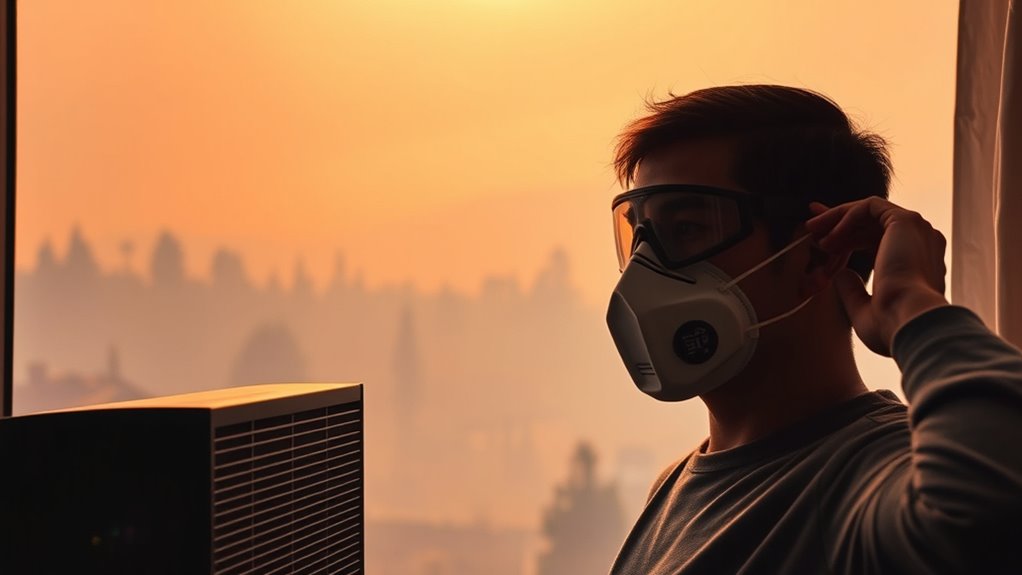
Staying informed and prepared during wildfire events is crucial for protecting yourself and your loved ones. Keep a close eye on local alerts and weather updates through trusted sources like your phone, radio, or community notifications. Prepare an emergency kit with masks, bottled water, and essential supplies in case you need to evacuate quickly. Develop a family emergency plan, including evacuation routes and communication methods.
Consider these steps:
- Sign up for local emergency alerts and alerts from health agencies
- Create a communication plan with family members
- Pack an emergency kit in advance, ready to grab at a moment’s notice
Being proactive helps you respond swiftly and minimizes health risks from smoke exposure during wildfire crises.
Frequently Asked Questions
How Do Wildfire Smoke Levels Vary by Region and Time of Day?
You might notice that wildfire smoke levels fluctuate based on your region and time of day. Typically, smoke concentrations are higher during peak fire activity and in areas closer to wildfires. You’ll often see increased smoky air in the afternoons, as winds shift and temperature changes occur. Monitoring local air quality reports helps you stay informed, so you can take precautions like staying indoors or using air purifiers when pollution levels rise.
Are Children or Pets More Vulnerable to Wildfire Smoke Exposure?
You might not realize it, but children and pets are even more vulnerable to wildfire smoke than adults. Their lungs are still developing, making them like delicate sponges soaking up harmful particles. Pets breathe faster and are closer to the ground, where smoke concentrates. Protect them by keeping windows closed, using air purifiers, and limiting outdoor time. Their health depends on your quick actions to keep them safe from invisible yet deadly dangers.
Can Indoor Plants Help Improve Air Quality During Wildfires?
Indoor plants can help improve air quality by absorbing some pollutants and increasing humidity, but they aren’t a reliable solution during wildfires. While they may make your space feel fresher, they don’t filter out harmful particles like smoke effectively. To protect your lungs, use high-efficiency air purifiers with HEPA filters, keep windows and doors closed, and avoid outdoor activities. Relying solely on plants won’t fully shield you from wildfire smoke.
What Are the Long-Term Health Effects of Wildfire Smoke Exposure?
You might wonder about the long-term health effects of wildfire smoke exposure. Prolonged inhalation can lead to respiratory issues like asthma, chronic bronchitis, and reduced lung function. It can also increase your risk of heart disease and develop into more serious conditions over time. To protect yourself, limit outdoor activities during smoke events, use air purifiers indoors, and consult a healthcare professional if you notice persistent symptoms.
How Effective Are Homemade Air Purifiers Compared to Commercial Units?
You wonder how homemade air purifiers compare to commercial ones. Homemade units can reduce some airborne particles, especially if you use a HEPA filter and proper fans. However, they often lack the advanced filtration and airflow control of commercial purifiers, making them less reliable for high pollutant levels. For better protection, investing in a certified air purifier is more effective, especially during wildfire smoke events.
Conclusion
Ironically, while you try to keep wildfire smoke out, it’s almost everywhere else you go. Your best defense is staying informed and prepared, yet the very act of venturing outside exposes you to the danger you’re trying to avoid. So, you shield your home and breathe easy indoors—only to realize that in the fight against smoke, the greatest challenge might be convincing yourself that you’re truly safe, even when the air outside is full of invisible threats.
